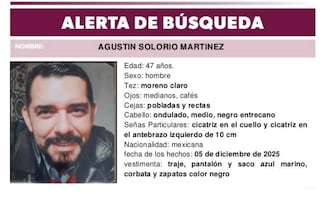Más Información

Pedro Haces niega nexos del extorsionador “Limones” con la Catem; felicita a las autoridades por la detención

Morena y aliados en el Senado aprueban aumentar aranceles a productos asiáticos; turnan al Ejecutivo

Niegan amparo a Emilio Lozoya por caso de Agronitrogenados; exdirector de Pemex busca librar acusación de lavado de dinero

SAT niega que se ordenará prisión automática contra contribuyentes sospechosos; reitera combate a evasión fiscal

Hombres armados matan a cinco personas en Salamanca, Guanajuato; reportan varias personas lesionadas
Two years ago Xiu Abarca Olea, 28, went to Chilpancingo market before sunset. That was the last time his family saw him. His mother Sara keeps looking for him.
Paola Yaneth, 21, went out on an errand to the store, three blocks away from her home in Aguascalientes. Three Christmases have gone by ever since, but she never returned.
On September 4, 2012, Cecilia Navarro, 52, left Valle Dorado, in the State of Mexico, for a meeting in Toluca. She did not attend her meeting, neither returned home. Her family recovered the Mondeo 2006 that she drove the day she left, but do not know her whereabouts.
Men and women disappear every day in Mexico. Specialists say that organized crime and human trafficking are the main reasons for the misery of thousands of Mexican families.
From 2006 to July 2015, 25,648 people went missing in Mexico, according to official figures.
Finding a missing person in Mexico is like finding a needle in a haystack. For the past 10 years, seven people have gone missing every day, and families across the country run into regulatory walls that instead of helping them, hamper their search.
Currently there is no general law on missing people and some public prosecutor offices ask families to wait for 72 hours before filing a complaint.
Mexico has the same number of missing people than Colombia in 62 years: 20,000 cases. Young people seem to be at greater risk. Five out of every 10 missing people are between 11 and 30 years old. Tamaulipas, State of Mexico, Nuevo León, Jalisco and Chihuahua are the states where more people vanish into thin air.
According to Eliana García, former head of the Human Rights Department of the Attorney General's Office (PGR), open investigations represent less than 50% of the actual number of missing people.
During the administration of former president Felipe Calderón, 13,816 people went missing in Mexico compared to the 5,304 people reported missing in 2014.
Many non-governmental organizations have filled the void left by authorities. In 1997, María Elena Solia Gutiérrez founded the Mexican Association for Stolen and Disappeared Children AC (AMNRDAC), after her granddaughter was stolen in late 1994 and recovered months later.
At the beginning the NGO sought mainly children, but now they "ask us for help for all types of cases: children, women, youth and elderly people," says Solia. “We go with them to the Public Prosecutor, hospitals and morgues. We are with them until they find their relatives," she added.
Social networks also play a role; "La Alameda" has posted photos of missing people in Mexico for three years. Currently it has a presence in 18 Mexican states.
Juan Carlos Guitérrez, coordinator of the NGO I(DH)EAS, Litigio Estratégico en Derechos Humanos, who used to work for the Human Rights Department of the Ministry of Interior, says that “in 99% of the cases authorities do not actually look for people. Plus, the PGR has 15 or 16 federal police looking for missing people, even though they should have over 500 people working on this task,” he explained.
(This story was written in collaboration with the Colombian newspaper EL TIEMPO).
Noticias según tus intereses
[Publicidad]
[Publicidad]









